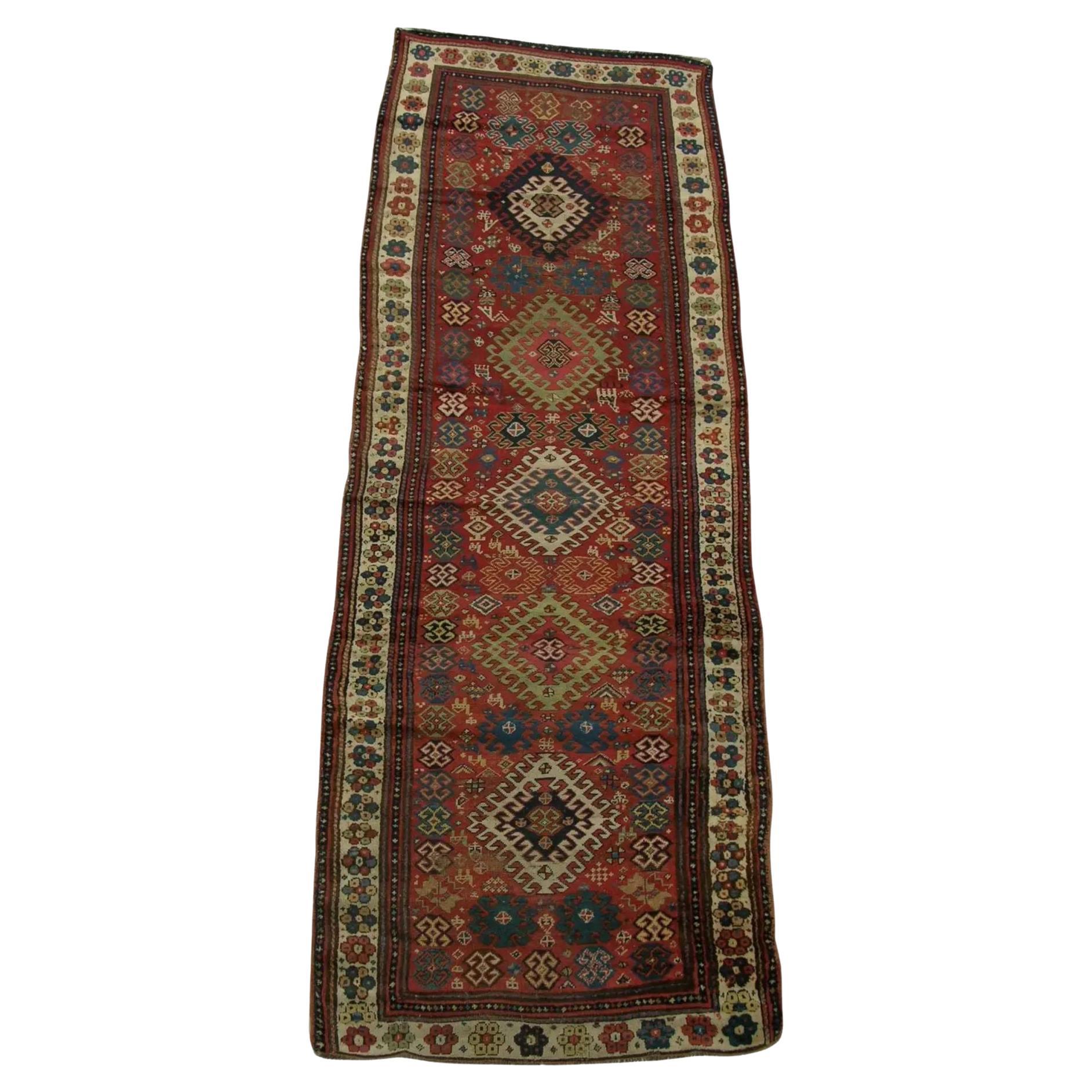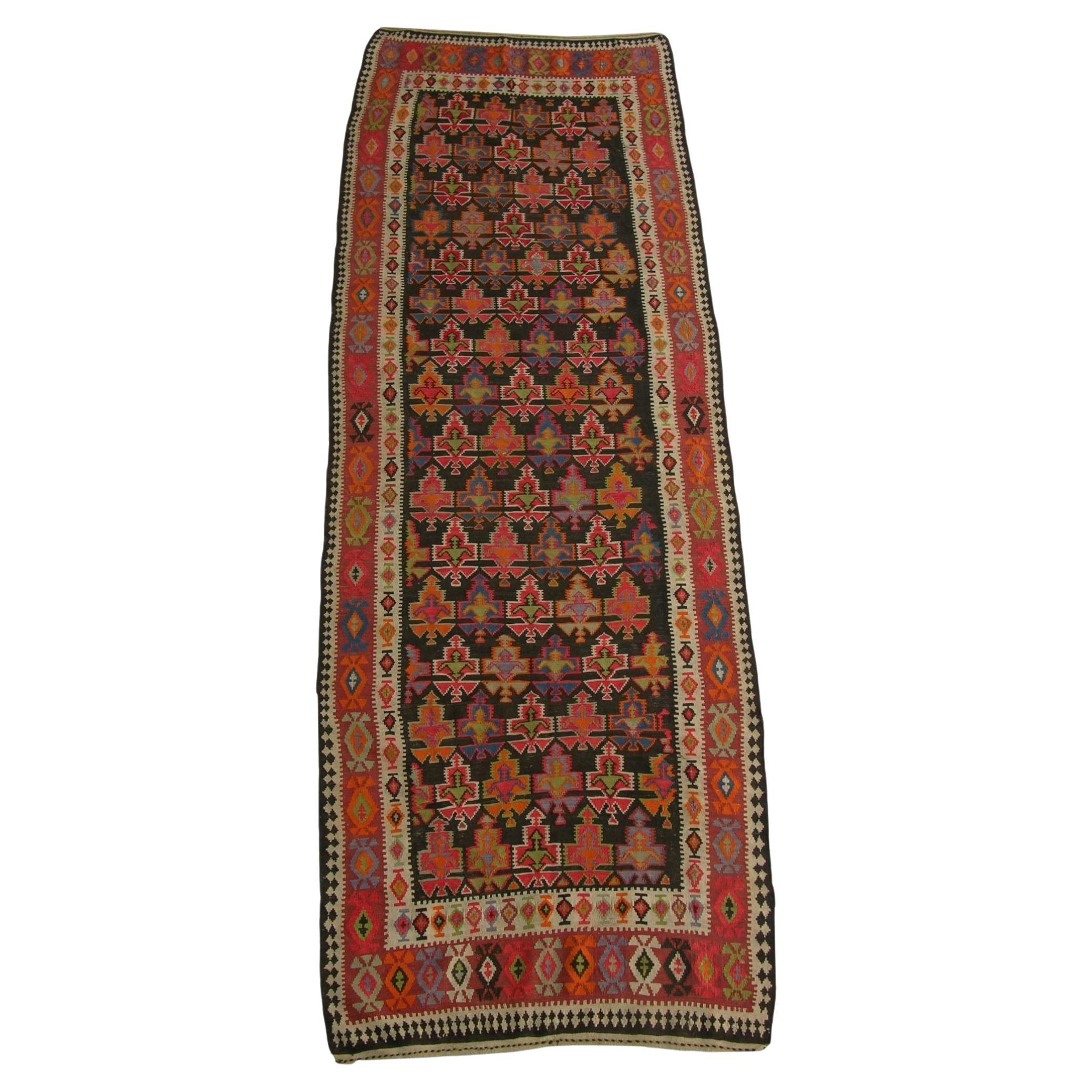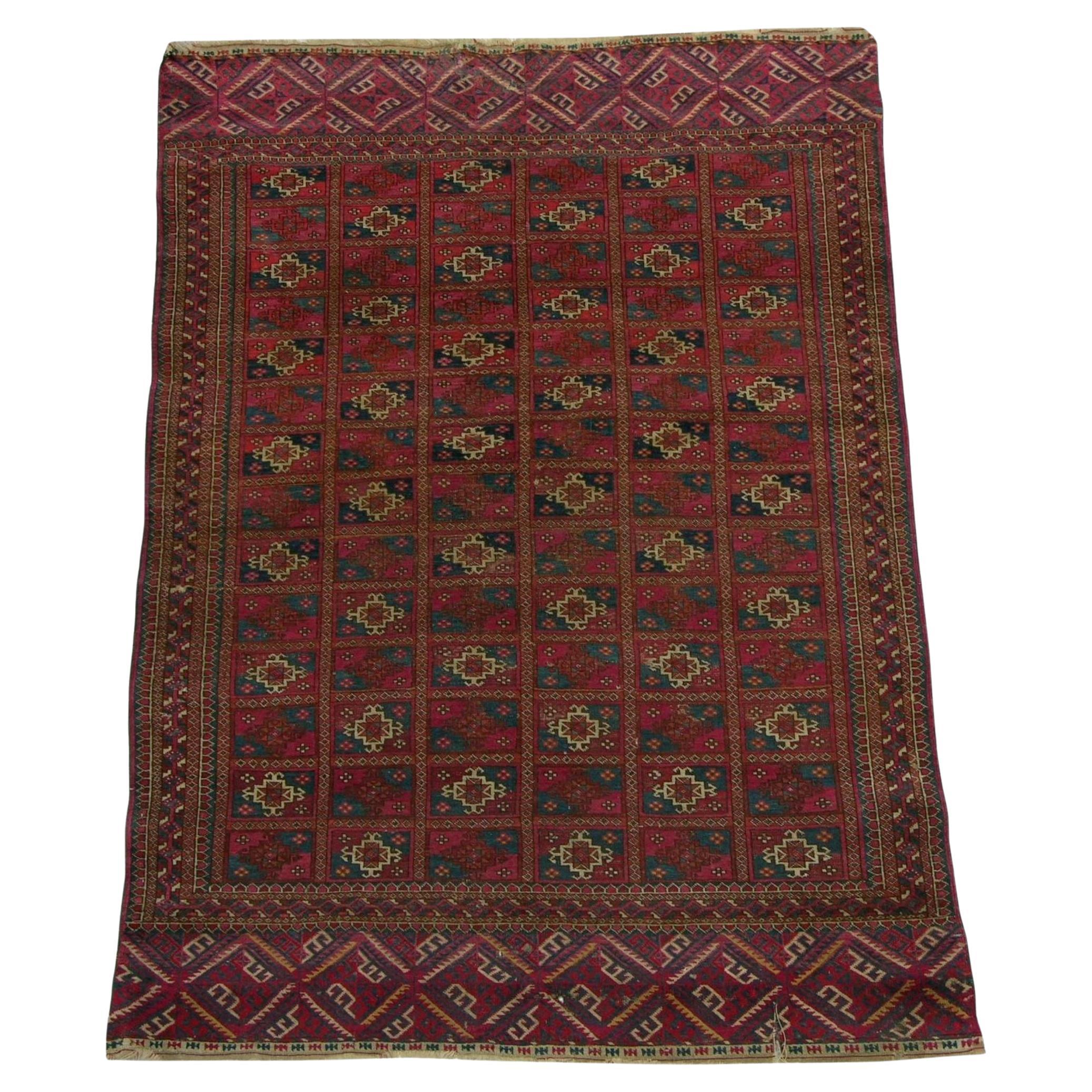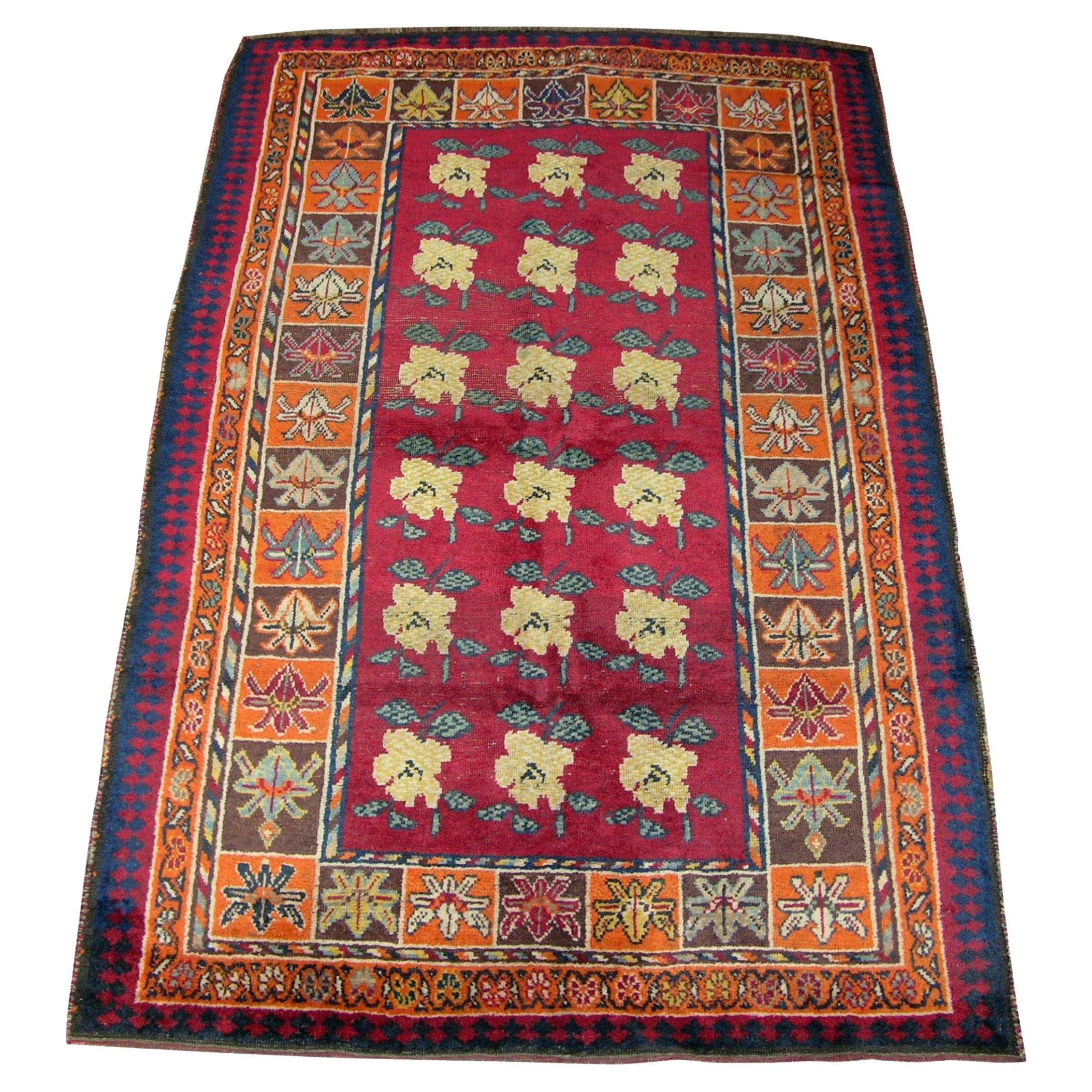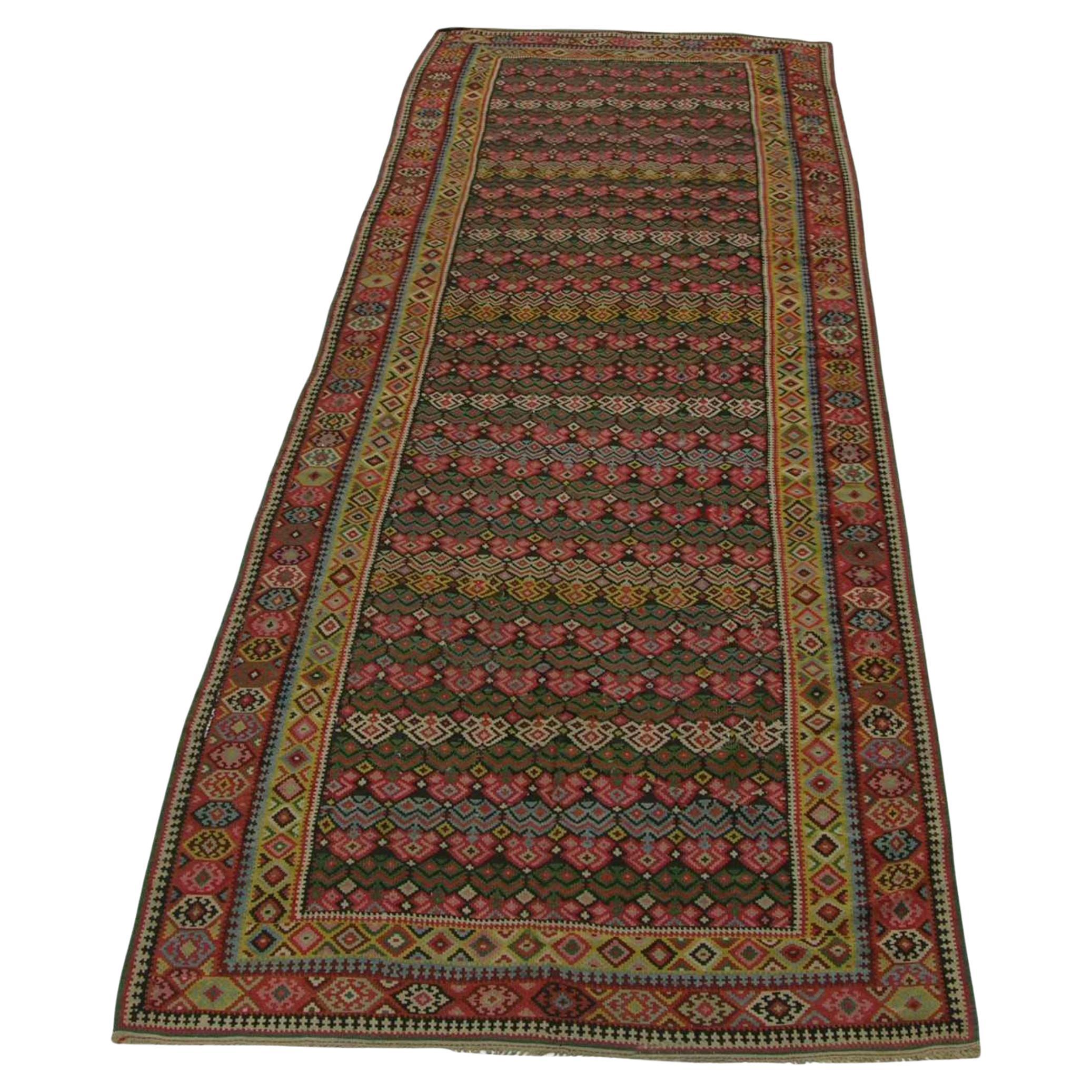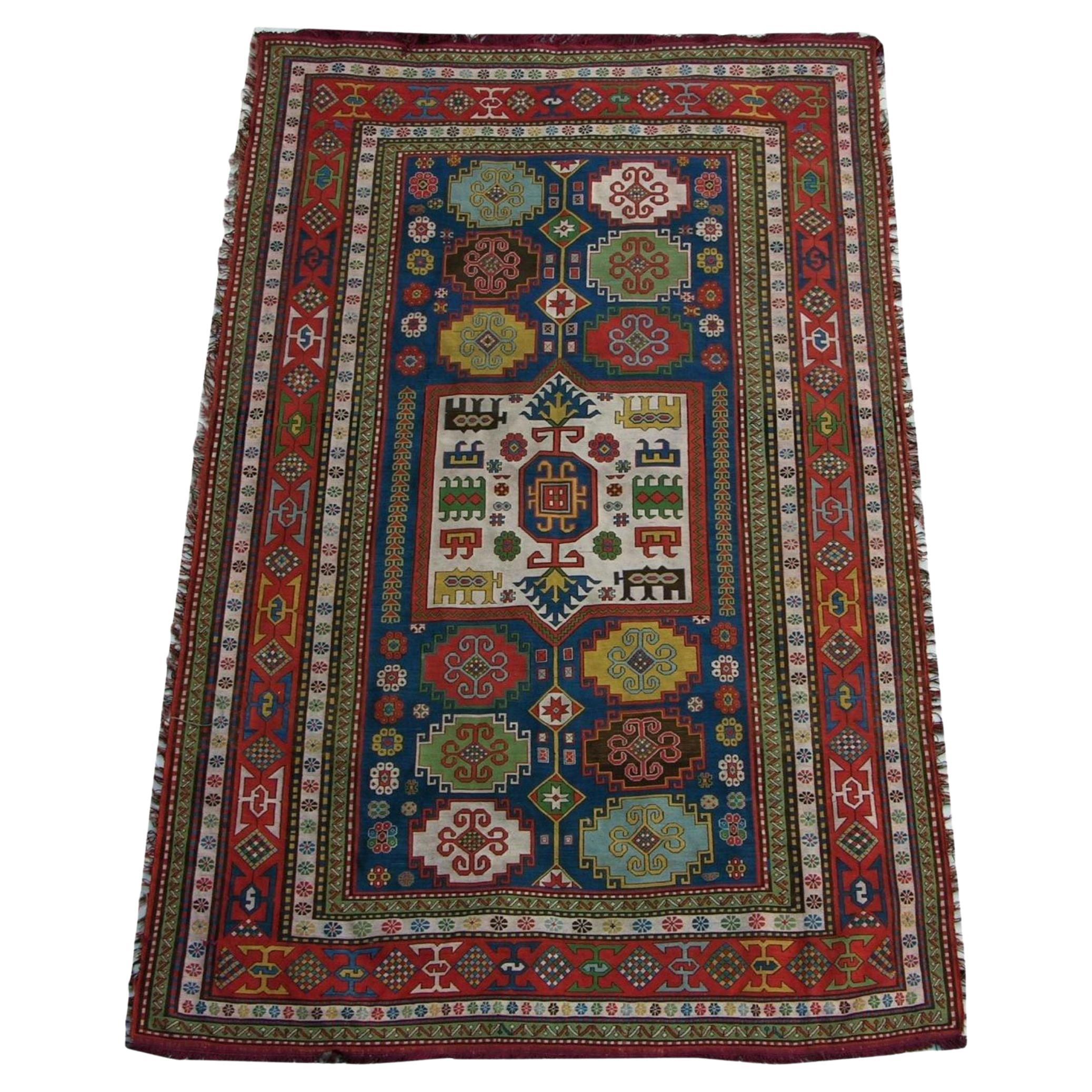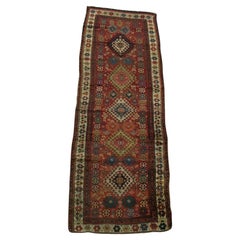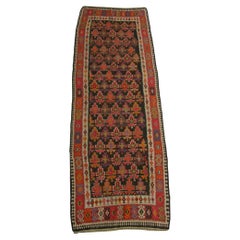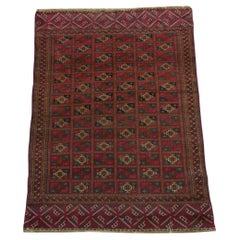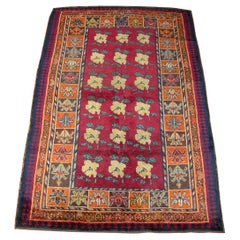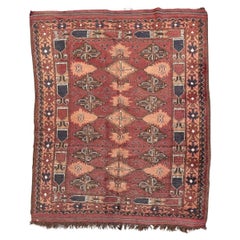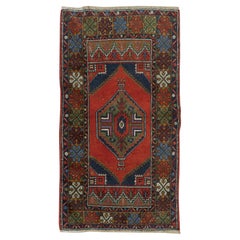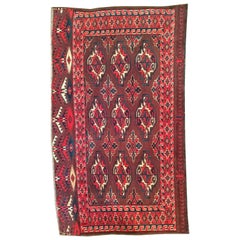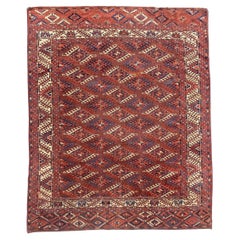Items Similar to Antique Nomadic Sumak Rug - 5'10'' X 4'3''
Want more images or videos?
Request additional images or videos from the seller
1 of 5
Antique Nomadic Sumak Rug - 5'10'' X 4'3''
$2,103
£1,587.99
€1,830.80
CA$2,968.23
A$3,271.90
CHF 1,712.02
MX$40,145.23
NOK 21,550.88
SEK 20,153.48
DKK 13,666.39
About the Item
Antique Nomadic Rugs:
– To most people the concept of the area rug, especially the pile rug, is virtually synonymous with the Orient, above all Persia and Turkey. Flat woven floor coverings in plain weave or tapestry technique are to all intents ubiquitous. They were developed all over the world, in various materials, from the earliest times by all peoples who possessed the skill of weaving.
In the case of knotted or pile carpets and rugs, the source is not so generalized. There is no doubt that the Middle East from Persia to Turkey became the main region for knotted carpet production from the Middle Ages onward, but it is very unlikely they were invented and first produced there.
Pile carpets are most immediately a decorative textile substitute for furry hides or sheepskins. Like the latter, their function relates to insulation and comfort as well as décor. Such woven versions of hides or hide rugs evolved for various reasons.
First, by shearing the animals and weaving the rugs out of the wool, it was no longer necessary to kill the animals to have a rug. And by weaving the rug it became possible to make it into a piece of decoration as well. One could dye hides in one color, or in several swaths of color, but it was not easy to make anything approaching a design in this way, at least not with any intricacy or permanence.
But a woven pile rug, could be given some sort of design, just like flat-woven textiles, while also imitating the texture, density, and protective quality of fur hides. This is how the pile rug came to be born, but the question is where?
From the outset it seems improbable that such an adaptation of fur hides took place in the warm climate of the Middle Eastf, except for the mountainous regions of Turkey, the Caucasus, and Persia. But mainstream Oriental rug weaving has always been primarily an urban industry, not a production of remote highlands.
Moreover, the many archaeological discoveries made in the last century tend to indicate that the earliest carpets were produced and invented beyond Central Asia in the High Altai Mountains of Siberia to the north and west of Mongolia. The inhabitants there were tent-dwelling nomads whose material culture was dominated by textile production.
Such people required rugs to protect them from the elements, in addition to embellishing their domestic environment. It seems that these peoples created the knotted pile carpet by about 600 B.C., if not earlier.
The specific evidence for this comes from the discoveries made by Russian archaeologists at the frozen tombs of Bashadar and Pazyryk in the High Altai region. The site of Bashadar produced a fragment of a pile carpet carbon dated to the sixth century B.C. Unfortunately, no pattern is discernible on this fragment, but at Pazyryrk another pile carpet was discovered damaged but virtually intact, date-able to the fifth or fourth century B.C. After conservation, its color and design turned out to be nothing less than astounding.
The center of the rug had a king of chessboard design with small floral motifs in each square. The borders also had floral designs, as well as a frieze of horsemen, one of griffins, and another of fallow deer. The palette had rich reds, soft greens, blue, and gold, with a velvety pile.
Because of its design and technical sophistication, some scholars have doubted that the Pazyryk carpet was a product of antique nomadic rugs. The frieze of horseman and the floral designs are clearly related to ancient Persian art, especially the reliefs at the great site of Persepolis. The weaving technique is also very fine, which, to some scholars at least, suggests urban workmanship or origin. Consequently, the Pazyryk piece has often been touted as the world’s oldest Persian rug. But this is most unlikely.
Other frozen tombs at Pazyryk produced fragments of ancient Persian flat woven tapestry textiles with figurative decoration. Since such textiles were imported by the Altai nomads, it is easy to see how designs from Persian court art could have reached them. The desire to imitate such intricate tapestry designs also explains why the weavers utilized a finely knotted technique, in order to reproduce such delicacy and detail. In addition, the frieze of deer is not Persian. They come from the local repertory of Nomadic “Scythian” art.
The evidence of the wool and dyes in the carpet is also decisive. The wool is identical in type to the wool of sheepskin hides found in other tombs at Pazyryk, which were clearly local. The red dye in the carpet is made from lac or kermesic acid, derived from insects, and the particular type of lac is specifically Polish or Baltic in origin.
This dye would have been more readily available to the wide-ranging Eurasian nomads who lived from Eastern Europe to the High Altai than to the ancient Persians far to the south. It is therefore most likely that the Pazyryk carpet was woven locally by nomadic peoples, even though its design reflected the cosmopolitan influences of far-off regions. Scholarship has come to recognize, moreover, that nomadic Asiatic weavings – rugs, tapestries, and embroideries – produced at various times and places generally tend to reflect the impact of urban textile production from the Middle East. The Pazyryk carpet is simply an early example of this phenomenon.
But even if knotted pile carpets were developed by Central Asian or Altaic nomads, the idea, if not the actual carpets themselves would have reached the Middle East by ancient times where the technique would have been adopted in local production.
It is very likely that the ancient Persians also made knotted carpets like their nomadic neighbors to the north, but these have not been preserved. Nor do we have actual pile carpets preserved from Greek and Roman culture.
Classical textual references to carpets exist, but they are ambiguous; they could simply refer to flat-woven floor coverings or blankets. Not until late antiquity in the burials of fifth-century A.D. Roman Egypt do we again encounter actual pile carpets, made now in a looped technique.
Around the same time there is also continued evidence of carpet production from Central Asia and the Caucasus, where pile carpet fragments have been discovered in caves. Fragments of first century A.D. pile rugs discovered on the western periphery of China and Tibet suggest that the nomadic tradition of the knotted carpet spread east and southward from the Altai region as well.
About the Seller
5.0
Platinum Seller
Premium sellers with a 4.7+ rating and 24-hour response times
Established in 1920
1stDibs seller since 2023
65 sales on 1stDibs
Typical response time: <1 hour
- ShippingRetrieving quote...Shipping from: Los Angeles, US
- Return Policy
Authenticity Guarantee
In the unlikely event there’s an issue with an item’s authenticity, contact us within 1 year for a full refund. DetailsMoney-Back Guarantee
If your item is not as described, is damaged in transit, or does not arrive, contact us within 7 days for a full refund. Details24-Hour Cancellation
You have a 24-hour grace period in which to reconsider your purchase, with no questions asked.Vetted Professional Sellers
Our world-class sellers must adhere to strict standards for service and quality, maintaining the integrity of our listings.Price-Match Guarantee
If you find that a seller listed the same item for a lower price elsewhere, we’ll match it.Trusted Global Delivery
Our best-in-class carrier network provides specialized shipping options worldwide, including custom delivery.More From This Seller
View AllAntique Caucasian Runner Rug - 10'8'' X 3'6'
Located in Los Angeles, US
Ca.1900 Antique Caucasian Rug 10'8'' X 3'6'', handmade and hand-knotted.
The antique Caucasian rugs get their name from the area in which they were made – the Caucasus. The Caucasus...
Category
Antique Early 1900s Kazakhstani Tribal Moroccan and North African Rugs
Materials
Wool
Antique Kilim Runner Rug 14'4'' X 4'10''
Located in Los Angeles, US
Antique Kilim Runner Rug 14'4'' X 4'10''
Category
Antique Early 1900s Asian Other Russian and Scandinavian Rugs
Materials
Wool, Cotton
Antique Fine Persian Baluch Rug
Located in Los Angeles, US
Baluch Rugs – Antique Baluch rugs are a unique phenomenon in the world of antique Oriental rugs. Rather than originating from one specific, easily identified region, Baluch rugs are ...
Category
Vintage 1920s Asian Tribal Russian and Scandinavian Rugs
Materials
Wool
19th Century Persian Tribal Gabbeh Rug
Located in Los Angeles, US
Persian Gabbeh Rugs – Persian rugs made with extra high pile and very simple, graphic designs focused on the use of color, which can be vibrant or soft and earthy. As pieces made for...
Category
Antique Early 1900s Tribal Russian and Scandinavian Rugs
Materials
Wool
Antique Kilim Runner Rug 17'2'' X 6'11''
Located in Los Angeles, US
Antique rugs that are called “Kilim rugs”, primarily refer to a type of flat weave rug that was produced without knotted pile. Because these antique rugs are found across the globe, ...
Category
Antique Early 1900s Asian Other Russian and Scandinavian Rugs
Materials
Wool, Cotton
Vintage Tribal Silk Soumak - 6'9'' X 4'3''
Located in Los Angeles, US
Soumak rugs (also spelled Sumak) – This construction technique produces a flat-weave rug that is thick, strong and exceptionally durable. Unlike kilims, Soumak rugs are not reversible because non-clipped yarns are left on the back. However, they are also stronger than kilims.
Antique Soumak carpets are unique because the wefts are used to produce decorative patterns rather than as a structural element. Antique Soumak rugs are generally very finely woven and feature richly detailed motifs. Traditionally, these spectacular flat-weave carpets are decorated with ancient symbols, tiny birds and geometric animals. Many of these geometric patterns and tribal symbols are associated with the Shahsavan tribe. In the 17th century, these influential warriors served as the personal bodyguards to Shah Abbas according to historic legends. The Shahsavan, who used Soumak weaving techniques widely, inhabited modern-day Azerbaijan and parts of Northwest Persia near Ardabil.
Because Soumak rugs were woven in various carpet producing regions, the designs they feature are exceptionally diverse. Although they are fairly rare compared to pile carpets and traditional kilims, antique Soumak rugs feature grand medallions, finely executed repeating patterns, Persian garden designs and tribal motifs that are surrounded by multiple sets of richly detailed borders. Antique Soumak rugs make outstanding floor coverings, but the technique was also used to construct bags, trappings, saddle covers, decorative bed spreads and functional household items. Like other regional handicrafts, antique Soumak rugs are highly decorative and diverse textile pieces that flatter modern furnishings and soften minimalist interiors very well.
Soumak or Sumak is a type of brocading or flat-woven pile. Thicker than a kilim carpet, it is accomplished by looping the yarn horizontally around successive pairs of warps in between passes of over-under wefting. When compressed vertically with a weaver’s comb, the resultant texture looks like cabling rising slightly from the surface of the rug. Soumak is named for the village of Shemaka in the Caucasus where this technique was widely practiced, but it certainly was not invented there. Soumak has been practiced extensively across the antique rug producing world, from Central Asia to Iran, the Caucasus, and Turkey.
Antique Soumak Weave Techniques:
Soumak Weave – The art of fine rug weaving and making is ancient and complex. Over the centuries, a myriad of disparate cultures, from every corner of the globe, have developed methods of creating tight, long-lasting weaves, such as rugs, carpets, and kilims.
As such, there is no singular, universal method for creating a fine weave; rather, there are several different, totally distinctive weaving techniques. These techniques and approaches have been developed over time and that are unique to the area, tribe and or people.
One specific example of a type of weave that was developed and is still used to this day is the Soumak weave. The widespread adaptation of the Soumak weave by such a wide range of different rug-producing cultures is certainly a rather strong testament to the quality and “reproducibility” of the process — cornerstones of any long-lasted artistic technique.
One of the most familiar types of antique weaving from the Caucasus region is the Soumak. These were produced in a wide array of designs, but generally they are typified by a crisp, precise drawing applied to highly abstract or stylized geometric patterns, using a rich and varied palette.
In technical terms, Soumaks are flatwoven rugs. Their technique is related to that of kilims, but it is somewhat more complex, thicker in handle, and more durable as floor covering. As opposed to Kilim technique which consists of compacted weft facing simply running over and under the vertical wraps, Soumak weave runs the yarns around the warps in a serpentine pattern, over two, back one, over two back one, and so forth.
The rows of this yarn facing or brocading are then separated by wefts like the rows of knots in pile carpets. The origin of this technique is hard to pinpoint, but it is attested literally from one end of the rug-producing world to the other.
The term Soumak is apparently a corruption of the name Shemaka, a town in the Shirvan region of the Caucasus, where such rugs, it is often claimed, were made. However Soumaks were made in various areas of the Caucasus and the region north of Kuba seems to have been a major center of their production.
Caucasian Soumaks have a very interesting design repertory, with a number of distinct types or groups. From the perspective of carpet history, the most interesting group is the one that utilizes field designs of large polygonal medallions, often in the shape of diamonds or stars.
These tend to be modeled on early Turkish pile carpets, especially those of the so-called “small pattern Holbein” and “large pattern Holbein” types produced in Western Turkey during the fifteenth and sixteenth centuries. A key feature of the Holbein rugs is the use of small squares with horn-like hooked pairs as fillers in the indentations along the edge of the main medallions.
Caucasian Soumaks of this type reproduce even these details with remarkable consistency and fidelity. The various smaller motifs used as space fillers seem to come from the common tribal repertory behind most Caucasian and Turkish rugs. The borders of Caucasian Soumaks tend to be made up of small geometric medallions or stylized rosettes, although they can be surprising, as on the example shown here which is adapted from kilim designs.
A second major group of Caucasian Soumaks have allover field designs made up of smaller medallions arranged closely in staggered repetition. Some of these which have multi-pointed star-like configuration (the so-called Crivelli-Star) also come from the repertory of early Turkish rugs. But the oval medallions with undulating edges are floral palmettes of classical Persian derivation.
Despite the varied origins of the design elements, the Soumaks of this group still convey considerable stylistic homogeneity or integrity. The borders of this second group are much the same as those of the first, although the example shown here has a highly unusual border that derives once again from early Turkish rugs.
A third group of Caucasian Soumaks stems from more local traditions. Known as “Dragon Soumaks...
Category
Vintage 1970s Tribal Russian and Scandinavian Rugs
Materials
Silk
You May Also Like
Bobyrug’s pretty vintage Turkmen rug
Located in Saint Ouen, FR
Pretty late 20th century Turkmen Afghan rug with beautiful decorative design and nice colours with a red brown field, orange and grey, entirely and finely hand knotted by wool on woo...
Category
Vintage 1980s Afghan Tribal Central Asian Rugs
Materials
Wool
3x5.6 Ft Vintage Oriental Accent Rug, Handmade Wool Carpet with Tribal Style
Located in Spring Valley, NY
A vintage Turkish rug. Finely hand-knotted with even medium wool pile on wool foundation. Very good condition. Sturdy and as clean as a brand new rug (deep washed professionally). Me...
Category
Mid-20th Century Turkish Tribal Turkish Rugs
Materials
Wool
$460 Sale Price
30% Off
Free Shipping
965 - Ancient Teke Rug 'Turkmenistan'
Located in Paris, FR
965 - ancient Teke rug (Turkmenistan).
Category
Antique 1890s Turkmen Tribal Central Asian Rugs
Materials
Wool
Bobyrug’s Nice Antique Turkmen Yumut Rug
Located in Saint Ouen, FR
Pretty late 19th century large yumut rug with beautiful tribal Turkmen design and nice natural colors, entirely and finely hand knotted with wool velvet on wool foundation.
✨✨✨
"Exp...
Category
Antique Late 19th Century Afghan Tribal Central Asian Rugs
Materials
Wool
Vintage Oriental Tribal Rug, Geometric Handmade Wool Carpet Area Rug
Located in Wembley, GB
This tribal area rug has been woven by hand in Turkey and features a fantastic tribal design. Two medallions decorate the central design woven in brown, blue, orange and cream accent colours on a rich red background. This is then enclosed by a highly decorative surround design and border. Both the colour and design in this fine wool rug make it the perfect accent piece for any room.
This fantastic wool rug features a fantastic diamond medallion design through the centre woven in cream beige and black accents, woven on a rich red background with elegant surrounding motifs and a highly decorative border.
Handwoven with the finest organic hand-spun wool, which has been dyed with organic vegetable dyeing techniques. Techniques have been used for generations due to the hardwearing nature of the materials and the vivid and subtle colour productions.
Suitable for use as a bedroom rug, living room, dining room or kitchen rug. Easily place this piece in a traditional or contemporary home interior of an instant uplift.
Vintage oriental tribal rug, geometric handmade wool carpet area rug...
Category
Mid-20th Century Turkish Tribal Turkish Rugs
Materials
Wool, Cotton, Natural Fiber, Organic Material
$775 Sale Price
25% Off
Vintage Malatya Kilim South Anatolia Nomadic Rug Turkish Carpet
Located in Moreno Valley, CA
Vintage Malatya Kilim South Anatolia Nomadic Rug Turkish Carpet.
Southern Anatolian Antique Kilim from the Malatya region with a rare and beautiful...
Category
Mid-20th Century Turkish Islamic Turkish Rugs
Materials
Wool
More Ways To Browse
Antique Persian Tapestry
Middle Eastern Tapestry
Persepolis Gold
Mongolian Fur Blue
Vintage Railway Posters
Wrought Bench
19th Century Leather High Back Chairs
1960s Teak Coffee Table
19th Century Cane Chairs
Antique English Stool
Antique Nesting Tables Furniture
Art Deco Walnut Armchairs
Boucle Fabric Dining Chair
Boucle Walnut Chair
Danish Lounge Chair With Ottoman
French Table And 2 Chairs
German Chrome Chairs
Mid Century Coffee Table Copper
